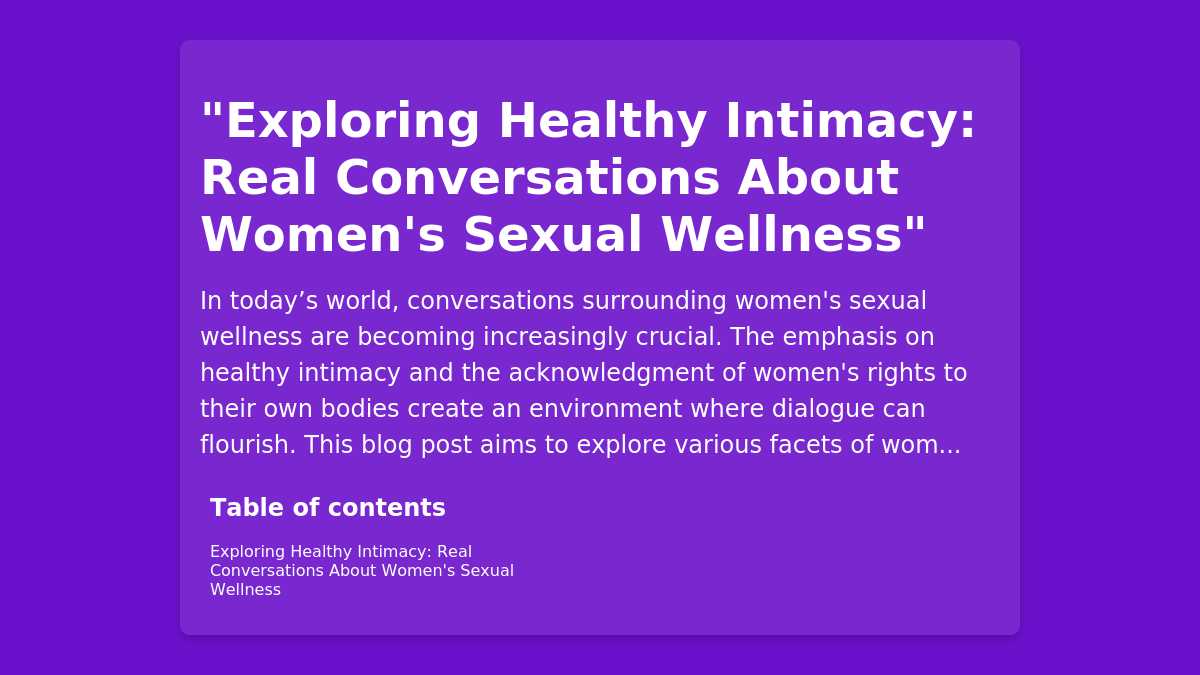Exploring Healthy Intimacy: Real Conversations About Women’s Sexual Wellness
Exploring Healthy Intimacy: Real Conversations About Women’s Sexual Wellness
In today’s world, conversations surrounding women’s sexual wellness are becoming increasingly crucial. The emphasis on healthy intimacy and the acknowledgment of women’s rights to their own bodies create an environment where dialogue can flourish. This blog post aims to explore various facets of women’s sexual wellness, from understanding anatomy to discussing the impacts of cultural norms. We will also discuss the role of communication in relationships and provide actionable tips for women to enhance their sexual well-being.
Understanding Women’s Sexual Wellness
Sexual wellness encompasses many aspects of women’s lives, including physical health, emotional well-being, and personal satisfaction. It is a holistic view that invites women to embrace their sexuality without shame or restraint.
What Constitutes Sexual Wellness?
| Aspect | Explanation |
|---|---|
| Physical Health | Access to regular health screenings and addressing sexual health issues. |
| Emotional Well-Being | Connection with one’s feelings and mental health’s influence on intimacy. |
| Knowledge and Education | Understanding one’s body, sexual rights, and healthy practices. |
| Communication | Open dialogue with partners and healthcare providers regarding preferences and concerns. |
The Anatomy of Intimacy
Understanding the Female Anatomy
To foster an environment of healthy intimacy, it’s essential to understand the female anatomy. Knowledge about one’s body can empower women to communicate their needs effectively.
| Component | Description |
|---|---|
| Clitoris | A highly sensitive organ that plays key roles in sexual arousal and pleasure. |
| Vagina | A muscular tube that connects the external genitals to the uterus, playing a role in sexual intercourse and childbirth. |
| Vulva | The external part of the female genitalia, including the labia, clitoris, and vaginal opening. |
| Uterus | Where fertilized eggs implant and develop during pregnancy. |
The Physiological Response to Arousal
Understanding the physiological aspects of sexual arousal can aid in creating realistic expectations around intimacy.
- Arousal Phase: Increased blood flow to the genitals results in swelling and lubrication.
- Plateau Phase: Heightened sensitivity and excitement lead to an increased heart rate and blood pressure.
- Orgasm Phase: Muscle contractions occur, leading to intense pleasure and release.
- Resolution Phase: The body returns to a resting state, often accompanied by feelings of relaxation and satisfaction.
Cultural Influences on Women’s Sexual Wellness
Societal Norms and Expectations
Cultural attitudes heavily influence women’s experiences regarding sexual wellness. Historically, many cultures have imposed restrictive norms about female sexuality, equating it to shame rather than empowerment.
- Positive Influences: Cultures that promote sexual education and acceptance often lead to healthier sexual relationships.
- Negative Influences: Societies that stigmatize female pleasure can create barriers to open dialogue and acceptance.
The Role of Communication in Healthy Intimacy
Why Communication Matters
The heart of any intimate relationship lies in effective communication. Conversations about sexual wellness help partners to understand and meet each other’s needs.
| Communication Style | Description |
|---|---|
| Open Communication | Honest sharing of desires, boundaries, and preferences. |
| Empathy | Understanding and validating each partner’s feelings and experiences. |
| Active Listening | Fully focusing on what the partner is saying without interrupting. |
Building Healthy Sexual Relationships
Identifying Personal Values
Before engaging in intimate relationships, it’s essential for women to identify their own values and boundaries.
- Self-Reflection: Take time to consider what intimacy means personally.
- Set Boundaries: Be clear about what is and isn’t acceptable.
Tips for Enhancing Intimacy
- Prioritize Time Together: Set aside uninterrupted time for connection and intimacy.
- Engage in Playfulness: Incorporate fun activities into your intimacy, such as games or role-play.
- Be Mindful: Approach intimacy with awareness, focusing on being present during the experience.
Challenges Women Face in Sexual Wellness
Common Obstacles
Women often face various challenges regarding sexual wellness, including:
| Challenge | Description |
|---|---|
| Lack of Knowledge | Limited education about anatomy and sexual health. |
| Performance Anxiety | Fear of not living up to the partner’s expectations. |
| Societal Shame | Feelings of guilt or embarrassment regarding sexuality. |
Overcoming Challenges
- Seek Education: Participate in workshops, read books, and consult professionals to increase knowledge.
- Therapy and Counseling: Consider seeking professional help to work through any psychological barriers.
The Importance of Regular Health Screenings
Key Health Screenings for Women
Regular health check-ups are critical for maintaining overall wellness and addressing sexual health concerns.
| Screening | Frequency | Purpose |
|---|---|---|
| Pap Smear | Every 3 years (ages 21-65) | Detects cervical cancer and HPV. |
| Breast Exams | As advised by a doctor | Early detection of breast cancer. |
| STI Testing | Annually or as needed | Identifies sexually transmitted infections early. |
Embracing Sexual Pleasure
The Significance of Self-Exploration
Self-exploration can foster a deeper understanding of personal desires, contributing to greater sexual satisfaction.
- Masturbation: A healthy way to explore personal pleasure without the pressure of performance.
- Sex Toys: Introducing various options can enhance pleasure and intimacy.
Creating an Empowering Environment
Women should cultivate environments that allow for exploration without judgment.
- Private Space: Create a sanctuary where exploration can occur comfortably.
- Positive Affirmations: Reinforce self-worth through affirmations about one’s body and sexuality.
Educational Resources for Sexual Wellness
Books and Online Platforms
A number of books and websites offer valuable information on women’s sexual wellness.
| Resource | Description |
|---|---|
| “Come As You Are” | A book by Emily Nagoski focusing on women’s sexuality and arousal. |
| Planned Parenthood | Offers sexual health resources and information. |
| OMGYes | A website that provides research-backed exploration of pleasure. |
Workshops and Support Groups
Participating in workshops or support groups can foster community and provide invaluable support.
- Local Health Clinics: Often provide educational workshops on sexual health.
- Online Forums: Engage with online communities focusing on women’s health and sexual wellness.
Conclusion: A Call to Open Dialogue
The journey toward understanding and embracing women’s sexual wellness is profound. The more we open the dialogue about intimacy, confront societal norms, and provide education, the healthier our relationships with our bodies and partners can become. By fostering a culture of understanding and acceptance, we empower women to claim their sexuality with confidence, joy, and authenticity. Let us continue to break barriers and explore healthy intimacy together.
Share with PDF: Download










Leave a Reply